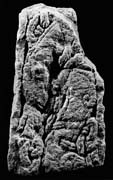Select a site alphabetically from the choices shown in the box below. Alternatively, browse sculptural examples using the Forward/Back buttons.
Chapters for this volume, along with copies of original in-text images, are available here.
Object type: Part of cross-shaft, in two joining pieces [1]
Measurements: H. 48 cm (18.9 in); W. 28.3 cm (11.1 in); D. 22 cm (8.7 in)
Stone type: Coarse-grained (with occasional quartzite pebbles up to 12 mm), very pale brown (10YR 7/4) grit; see no. 2
Plate numbers in printed volume: 14-17
Corpus volume reference: Vol 3 p. 55-56
(There may be more views or larger images available for this item. Click on the thumbnail image to view.)
A (broad): The edge moulding is plain and flanks a continuous panel containing a pair of interlocked profile beasts with double outlines. The ribbon bodies have spiral leg joints incised out of the contoured edge. The ear is extended into a median-incised fetter band which penetrates the torso at two points. The sculptor has accommodated the beasts and fetters to depressions in the surface of the stone.
B (narrow): This side is worn and has a narrower edge moulding. The simple panel contains the remains of a fettered profile beast with double outline and spiral joint. Only the central portion survives. The fetter is densely knotted about the torso and above the back.
C (broad): The plain edge moulding is slightly narrower than on face A. The upper part of the panel is filled with a fan of roughly cut strips, broken at the top. Below are the terminals of a four-cord interlace, using broad, median-incised strands.
D (narrow): An edge moulding, varying in width, flanks a continuous panel filled with a form of linked or looped interlace using broad, median-incised strands. The pattern is four-cord but resembles knitting stitch in its looping technique. It becomes disorganized as the panel tapers.
This is less accomplished carving than no. 2. Its beasts are larger and less sophisticated in both detail and disposition, yet the principal face may lie behind the single beast panels of the Middleton-Sinnington series (See Chap. 9). The penetration of the torso of the beast by the the fettering strand is rare in Anglo-Scandinavian designs, but does occur on a gilt-bronze figure from Kaupang, Norway (Wilson and Klindt-Jensen 1966, pl. XXIII, d).
The fan motif is found on Sherburn 6 (Ill. 779), and the knitting stitch interlace occurs in a more controlled form on Leven 1 (Ill. 628). The monument is a poorer example of the York Metropolitan School where interlace and animal ornament are often juxtaposed on adjacent faces. Whilst the animal ornament expresses the contemporary taste in Yorkshire for fettered profile beasts, the panels of interlace speak of the continuity of late Anglian motifs.
1. All the pieces from the Minster were discovered as a result of the excavations of 1966-71 by H. Ramm and D. Phillips. They are to be published as a handlist, together with a critical essay, in the forthcoming Royal Commission volume on the excavations. That publication will provide the finer detail of their archaeological contexts, both in a table, and in a description of the excavation of the south transept cemetery.
The following are general references to the stones: Wilson 1978, 142; Hall 1980b, 7, 21; Lang 1988b, 8, 12; Lang 1989, 5.



